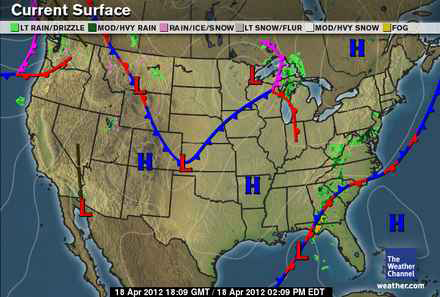Weather and Songbird Migration: April 18,
2012
Dr.
David Aborn |
Dear Students:
Well, migration has progressed, but more as a trickle than the flood I predicted last week. There were a lot of migrants stuck along the Gulf Coast because of the high pressure over much of the country, and once that high pressure moved east and winds became southerly, I expected a lot of migrants to take off and head north. They did head north, but in more of a steady stream, rather than a big wave, and the good tailwinds helped get them pretty far north. Cliff Swallows, Yellow Warblers, Common Yellowthroats, and Hooded Warblers have arrived in Michigan. Blue-headed Vireos, Barns Swallows, and Tree Swallows arrived in Vermont and New Hampshire. Blackburnian Warblers, American Redstarts, Northern Waterthrushes, and Black-and-white Warblers made it all the way to Maine! In last week's report, I also mentioned that another front was bringing rain to the Pacific Northwest, and that produced the West's first fallout. One birder in Coos Bay, Oregon tallied over 100 Yellow-rumped Warblers, over 50 Tonsend's Warblers, and more than 30 Orange-crowned Warblers. Other birders reported good numbers of Nashville, Wilson's, and Black-throated-gray Warblers, and Black-headed Grosbeaks.
Fallouts!
As that western front moved east, it created poor flying conditions in the Gulf region earlier in the week and forced many birds to land. Once again, it was High Island, Texas that saw the greatest fallout, and once again it was Tennessee Warblers that dominated; they counted over 600 of them! They also said there were a lot of Rose-breasted Grosbeaks, Scarlet Tanagers, Indigo Buntings, and Baltimore Orioles. People also saw the first Blackpoll Warblers, Bay-breasted Warblers, and Black-billed Cuckoos of the spring. While flying conditions were poor in the East, flying was good out West, as a new influx of birds arrived. In the San Diego, Calif. area, birders saw over 100 Black-headed Grosbeaks, over 75 Bullock's Orioles, and Vaux's Swifts arrived. Eight warbler species were seen in Santa Barbara, along with many Rufus Hummingbirds. The southerly winds helped push Violet-green Swallows and Barn Swallows as far north as Washington.
What Can We Expect This Week?
Things look pretty similar for the coming week:
 |
-
The front that created the Texas fallout has moved of the eastern US, which means migrants haven't been able to go anywhere for a couple of days. Conditions are supposed to clear tomorrow, but the birds had better move quickly, because there is another front behind it.
-
While the first front was mostly a rain maker, this second one has some pretty good northerly winds behind it. This means there could be more fallouts, and birds that arrive won't be able to make it very far for several days.
-
Out West, high pressure has already moved far enough east that winds are southerly, which will allow for more migrants to arrive from the tropics, and those that are already here will be able to make good progress on their migration.
We are heading into the peak of migration, and there should be lots to see!
Take Care.
David Aborn
North
Chickamauga Creek Conservancy
Chattanooga, TN



